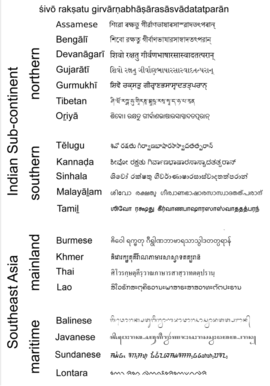Sanskrit phonology
| Sanskrit | |
|---|---|
|
saṃskṛtam संस्कृतम् |
|

Sanskrit literature by Kālidāsa in various Indic scripts
|
|
| Pronunciation |
[sə̃skr̩t̪əm] |
| Region |
Indian subcontinent parts of Southeast Asia |
| Era | ca. 2nd millennium BCE – 600 BCE (Vedic Sanskrit), after which it gave rise to the Middle Indo-Aryan languages. Continues as a liturgical language (Classical Sanskrit). |
| Revival |
A few attempts at revival have been reported in Indian and Nepalese newspapers. India: 14,135 Indians claimed Sanskrit to be their mother tongue in the 2001 Census of India: Nepal: 1,669 Nepalis in 2011 Nepal census reported Sanskrit as their mother tongue. |
|
Indo-European
|
|
|
Early form
|
|
|
Devanagari (official) Also written in various Brahmic scripts. |
|
| Language codes | |
| ISO 639-1 | sa |
| ISO 639-2 | san |
| ISO 639-3 | |
| Glottolog | sans1269 |
A few attempts at revival have been reported in Indian and Nepalese newspapers.
India: 14,135 Indians claimed Sanskrit to be their mother tongue in the 2001 Census of India:
Sanskrit (IAST: Saṃskṛtam; IPA: [sə̃skr̩t̪əm]) is the primary liturgical language of Hinduism; a philosophical language of Hinduism, Sikhism, Buddhism, and Jainism; and a literary language and lingua franca of ancient and medieval India and Nepal. As a result of transmission of Hindu and Buddhist culture to Southeast Asia and parts of Central Asia, it was also a language of high culture in some of these regions during the early-medieval era.
Sanskrit is a standardized dialect of Old Indo-Aryan, having originated in the second millennium BCE as Vedic Sanskrit and tracing its linguistic ancestry back to Proto-Indo-Iranian and Proto-Indo-European. The oldest Indo-European language for which substantial written documentation exists, Sanskrit holds a prominent position in Indo-European studies. The body of Sanskrit literature encompasses a rich tradition of poetry and drama as well as scientific, technical, philosophical and religious texts. The compositions of Sanskrit were orally transmitted for much of its early history by methods of memorization of exceptional complexity, rigor, and fidelity. Thereafter, variants and derivatives of the Brahmi script came to be used.
...
Wikipedia
